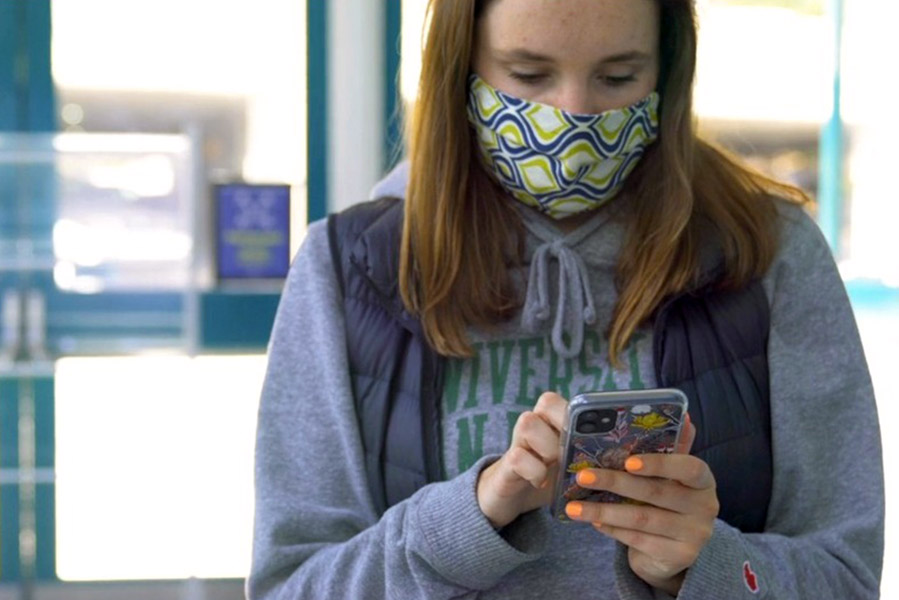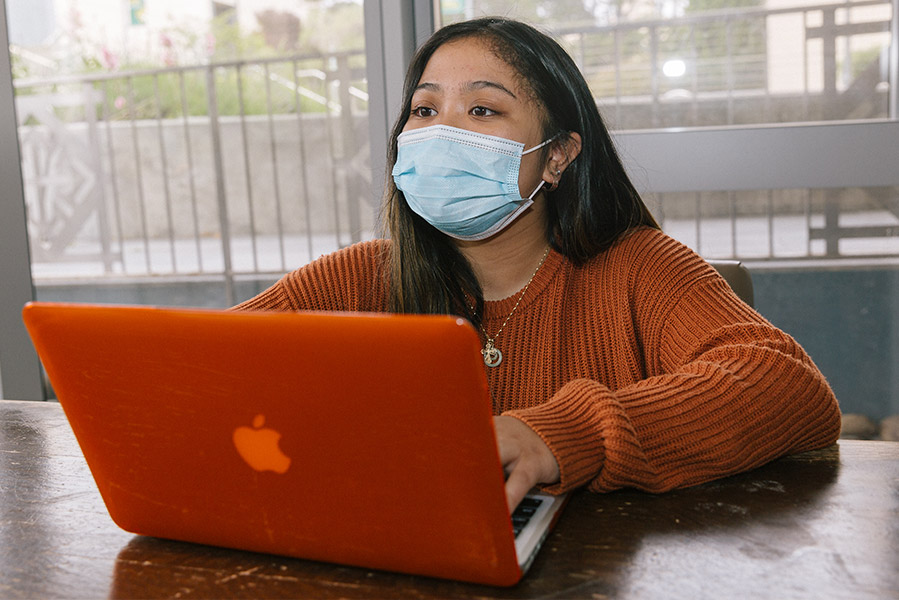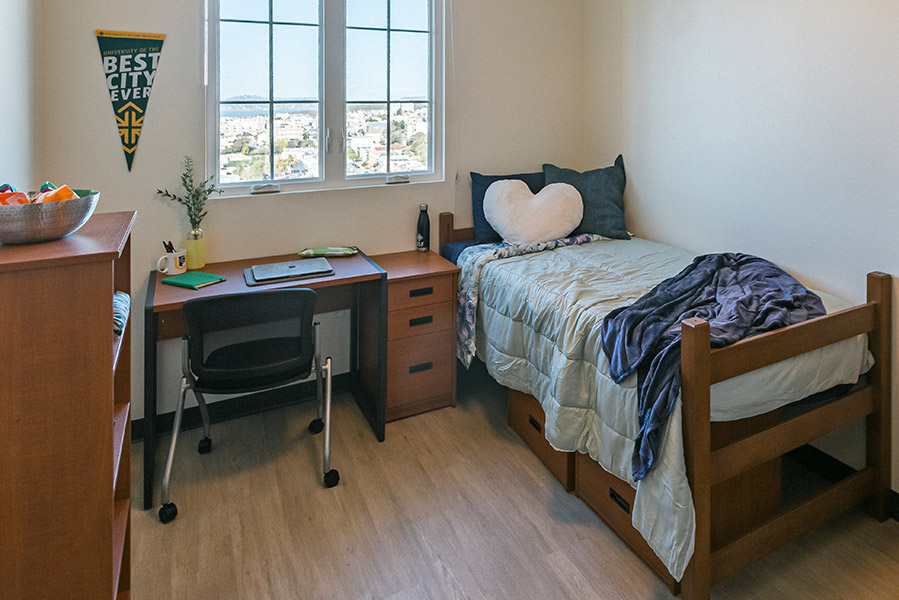Stay Safe Together
Classrooms, offices, and residence halls have been set up to best protect students, faculty, and staff. To help the whole community stay safe, we will follow the procedures and protocols set forth by health officials.
Please use this site as your single source for all announcements and actions related to life on campus. And please note that all plans are subject to change.

What you need to do.

Protocol for a safe community.

What you need to know.
COVID-19 Prevention
As of Wednesday, Oct. 19, 2022, face coverings are optional indoors and outdoors on campus. The deans, faculty, librarians, and staff instructors may ask their students to continue wearing face coverings in classrooms. For more information, please review the Oct. 14 message to the campus community.
The University of San Francisco requires all students to be fully vaccinated for COVID-19 and to have boosters when eligible. All faculty and staff, except those who have an exemption approved by Human Resources, are encouraged to be fully vaccinated (including boosters) as soon as they are eligible.
Please review the full COVID-19 Prevention Plan for more details.
To operate safely in person, USF is following state and local public health guidance and is building upon current COVID-19 safety measures, including recommendations on vaccinations, face coverings, testing, cleaning and disinfecting procedures, hygiene practices, symptom monitoring, and more. Classes, residence halls, and dining facilities have been set up to best protect students, faculty, and staff using the above guidelines. We are in regular communication with public health officials and other experts, and adjust our plans and procedures as necessary based on the course of the pandemic.
Yes. The University of San Francisco requires all undergraduate and graduate students to be fully vaccinated for COVID-19 and to have boosters when eligible. The vaccination requirement went into effect at the start of the fall 2021 semester, and the booster requirement is effective Jan. 21, 2022. All faculty and staff are encouraged to be fully vaccinated (including boosters). Vaccinations continue to be the best way to protect our community.
COVID testing through GoHealth for students, faculty, and staff is available on Mondays from 1-3 p.m., Wednesdays from 1-3 p.m., and Thursdays from 9:30-11:30 a.m. in University Center 501. To register, please visit HPS COVID-19 Resources.
Students, faculty, and staff who are reporting symptoms and who identify as close contacts will receive instructions for testing from the COVID tracing team. Drop-in hours for symptomatic testing, close-contact testing, and end-of-isolation testing is offered on the fifth floor of University Center. Students with approved exemptions will continue to be required to test weekly at GoHealth testing and have received additional information.
Unvaccinated students arriving from outside of California to live in on-campus housing are expected to quarantine for seven days. Students living in on-campus housing will quarantine either in their unit or in a room designated for quarantine as the situation dictates. Quarantine accommodations will be provided for the seven days prior to any orientation activities or the start of classes. While in quarantine, meal delivery service will be available.
Unvaccinated students arriving from outside of California and living off-campus are required to quarantine for seven days. They may quarantine in their off-campus residence.
Fully vaccinated students will not need to quarantine.
It is important to report the results of a positive test, either by emailing covidtracing@usfca.edu or by filling out the Positive COVID-19 Case Intake Form. Any reported close contacts will be notified and guided through the next steps. An abridged version of USF’s COVID-19 contact tracing protocol is available on USF Together.
For those who believe they qualify for an accommodation to their work, as required by law, USF will engage in the interactive process to determine if accommodations are necessary, reasonable, and feasible. The process for requesting an accommodation is detailed on myUSF. This process will determine if a reasonable accommodation can be made to remove barriers so the employee can perform the essential functions of their job. The objective of the process is to remove obstacles that keep employees from performing their jobs. Employees who want to explore this process can contact leaves@usfca.edu.
Course Delivery
We have invested in hyflex (hybrid-flexible) classrooms, portable equipment, and faculty training initiatives. We can accommodate cohort models in which different groups of students join classes in-person on specific days, while participating remotely (either synchronously or asynchronously) on other days. Several non-academic spaces have been converted to classrooms and we are also studying the possibility of conducting classes outside. Deans may make adjustments to course modalities for pandemic-related reasons. Finally, faculty, librarians, and staff who are unable to teach and work in-person for documented medical reasons will be able to request an accommodation through the Office of Human Resources.
- In-Person Instruction is what we call formats in which a class meets on-campus in-person for every class session.
- Hybrid instruction is what we call formats in which a class consists of a mixture of on-campus in-person and remote/online learning.
- The class does not meet on-campus every session. Some instructors may choose to deliver remote/online sessions through remote synchronous meetings (e.g., via Zoom) or through asynchronous work for all students in the class.
- The instructor is on campus for every class session. Half of the students in the class meet in-person on one set of days (cohort A) while the other half of the students in the class (cohort B) are asynchronous. The cohorts switch for the next class session. Like HyFlex instruction, the instructor always holds classes in-person for at least half of the class.
Generally, curriculum content in hybrid courses is delivered less than 50%, but more than 0%, through remote/online learning and at least 50% of curriculum content is learned through on-campus in-person instruction. For fall 2021 only, up to 50% of instruction may be delivered through remote/online learning.
- HyFlex instruction is what we call formats in which a class meets on-campus in-person for every class session, with synchronous remote participation for some students.
- Remote instruction is what we call formats in which a course is taught basically the same way it can be as an in-person course, but every class session is delivered remotely with synchronous meetings (e.g., via Zoom). There could be some additional asynchronous learning. Emergency remote is a form of remote instruction that is implemented quickly in response to an emergency situation.
- Online instruction is what we call formats in which a course has been designed (and approved) specifically to be taught completely online, primarily through asynchronous learning with some synchronous elements.
Deans are working with their faculty on options for students who must continue online, including offering remote sections of courses and the ability to join an in-person class remotely, also known as “hyflex” technology.

